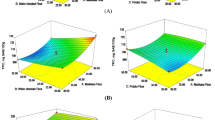Abstract
The nutrient and antinutrient components of tubers from seven cultivars ofDioscorea alata were determined. The average crude protein content ofD. alata tubers was 7.4%. Starch (75.6–84.3%) was the predominant fraction of the tuber dry matter. Significant differences in crude protein and starch contents were observed among cultivars. Vitamin C content of the yam tubers ranged from 13.0 to 24.7 mg/100 g fresh weight. The results showed yams to be reasonably good sources of minerals. Phytic acid contents of the yams were low, with values ranging from 58.6 to 198.0 mg/100 g dry matter. Total oxalate levels in yam tubers were found to be in the range of 486–781 mg/100 g dry matter, but may not constitute a nutritional concern since 50–75% of the oxalates were in the water-soluble form. The overall results are suggestive of the nutritional superiority of yams compared to other tropical root crops.
Similar content being viewed by others
References
Onwume IC (1978) The tropical tuber crops: Yams, cassava, sweet potato and cocoyams. Chichester: John Wiley & Sons.
AOAC (1975) Official Methods of Analysis, 12th ed. Washington, DC: Association of Official Analytical Chemists.
Pucher WG, Leavenworth CS, Wickery HB (1948) Determination of starch in plant tissues. Anal Chem 20: 850–853.
Dubois M, Gilles KA, Hamilton JK, Rebers PA, Smith E (1956) Colorimetric methods for determination of sugars and related substances. Anal Chem 28: 350–356.
Bradbury JH, Holloway WD (1988) Chemistry of tropical tuber crops: Significance for nutrition and agriculture in Pacific. Canberra: Australian Centre for International Agriculture Research.
Freed M (1966) Methods of Vitamin Assay, 3rd ed. New York: Interscience, p. 67.
Anon (1979) Selected methods for soil and plant analysis. Ibadan (Nigeria): International Institute of Tropical Agriculture.
Chapman H, Pratt EF (1961) Methods of analysis of soil, plant and water.University of California, Davis, Division of Agricultural Science.
Wheeler EL, Ferrel RE (1971) A method for phytic acid determination in wheat and wheat fractions. Cereal Chem 48: 312–316.
Abaza RH, Blake JK, Fisher EJ (1968) Oxalate determination: Analytical problems encountered with certain plant species. J Assoc Off Anal Chem 51: 963–967.
SAS (1982) SAS/STAT Guide for Personal Computers, Version 6 Ed. Cary, NC: Statistical Analysis System, Inc.
Bradbury JH (1988) The chemical composition of tropical root crops. ASEAN Food J 4: 3–13.
FAO (1972) Food Composition Table for Use in East Asia. Rome: Food and Agriculture Organization.
Baquar SR, Oke OL (1976) Protein in Nigerian yams (Dioscorea spp.). Nutr Rep Int 14: 237–248.
Martin FW, Thompson AE (1973) Protein content and amino acid balance of yams. J Agric Univ Puerto Rico 57: 78–83.
Splittstoesser WE, Martin FW, Rhodes AM (1973) The amino acid composition of five species of yams (Dioscorea). J Am Hort Sci 98: 563–567.
Bradbury JH, Singh U (1986) Ascorbic acid and dehydroascorbic acid content of tropical root crops from South pacific. J Food Sci 51: 975–987.
Coursey DG, Aidoo A (1963) Ascorbic acid levels in Ghanian yams. J Sci Food Agric 17: 446–449.
Egbe TA, Treche S (1984) Variability in chemical composition of yams grown in Cameroon. In: Tery ER, Toko EU, Arene OB, Mahungu NM (eds) Tropical root crops: Production and uses in Africa. Ottawa: International Development Research Institute, pp. 157–160.
Ologhobo AD (1985) Biochemical assessment of tubers of NigerianDioscorea species (yams) and yam peels. Trop Agric (Trinidad) 62: 166–168.
Libert B, Franceschi VR (1987) Oxalate in crop plants. J Agric Food Chem 35: 926–938.
Reddy NR, Sathe SK, Salumkhe DK (1982) Phytates in legumes and cereals. Adv Food Res 28: 1–92.
Baquar SR, Oke Ol (1977) Mineral constituents of Nigerian yams. Nutr Rep Int 15: 265–272.
Harischandra SN (1987) Evaluation and characterization of some commonly cultivatedDioscorea accessions in Sri Lanka, M. Phil. Thesis. Postgraduate Institute of Agriculture, University of Peradeniya, Sri Lanka.
Author information
Authors and Affiliations
Rights and permissions
About this article
Cite this article
Wanasundera, J.P.D., Ravindran, G. Nutritional assessment of yam (Dioscorea alata) tubers. Plant Food Hum Nutr 46, 33–39 (1994). https://doi.org/10.1007/BF01088459
Received:
Accepted:
Issue Date:
DOI: https://doi.org/10.1007/BF01088459




